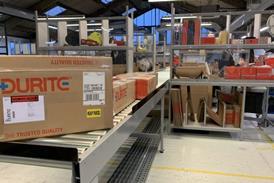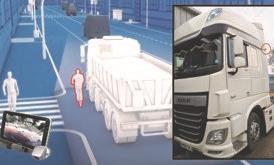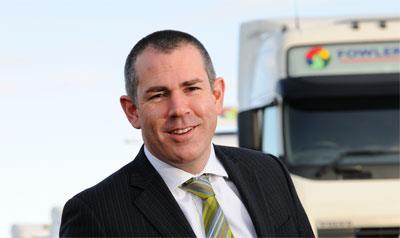
Fowler Welch’s move into ambient distribution alongside its chilled business is already paying dividends as MD Nick Hay tells Steve Hobson
Although Nick Hay - MD of Fowler Welch since November 2010 – has, like the firm he runs, a background in chilled distribution, he sees ambient markets as far more happy hunting grounds. As Stobart’s withdrawal from the chilled market demonstrates, this has become a price-led commodity business where operators struggle to make money.
Spalding-based Fowler Welch (FW) got into the ambient market back in 2006 with the acquisition of Stockport haulier RF Fielding, a move that is expected to be key to Fowler Welch’s growth in profitability when parent Dart Group announces its 2012/13 full-year results in June.
In the year to 31 March 2012, FW made an operating profit of £2.8m on turnover of £144m; in the first half of six months of 2012 revenue was up 8% and profit was up 33%. “Our overall revenue growth for the full year won’t be quite as strong as 8%,” says Hay. “The first half of the year is also more profitable than the second half, so in terms of profitability we should be looking at growth of 20% to 25%. The outlook is pretty good – it is really about improving yield across the whole business.”
The 2011/12 results were boosted by a turnaround in performance at FW’s 50,000-pallet ambient DC at Heywood near Bury, Greater Manchester, which opened in 2010. “We have really pushed our ambient business forward,” says Hay. “It had a difficult time in late 2010 when we increased capacity and had some operational challenges, but now it is really motoring.”
Chilled still important
Hay insists that FW is not turning its back on the chilled business, which is based on a 32-acre site in Spalding, Lincolnshire, despite a couple of setbacks. “We increased capacity in Spalding and filled it, we increased capacity at Hilsea and will have filled that before the year end,” he says. “We have had a couple of tough areas though. Our European business is slightly challenging and we lost one large contract there, and revenue has dropped in Kent - but in calendar year 2013 that will recover again.”
Another profit driver has been the strides FW has made in improving fuel economy across its fleet of 400 trucks, a mixed fleet of 6x2 tractor units. “We have made massive progress on mpg,” says Hay. “It has improved 6% and when you are spending over £20m on fuel that is a big number.”
While Hay says it is difficult to be precise about the split between ambient and temperature controlled revenues, because a number of ambient sites also use chilled trailers, he estimates that ambient will be roughly 30% of the business by year end. “We went into ambient because we believed the ambient supply chain was going to speed up,” he explains. “The cost of entry into ambient is much lower than chilled so there are an awful lot of players in there. But we believe - and are now proving - that there are a number of manufacturers and retailers who need a faster [ambient] supply chain.
“So we provide day one for day two for many customers, and we’re seeing the amount of picking for ambient increase all the time. We are bringing our chilled skills to ambient and so there is a definite opportunity to grow. A lot of our ambient competitors are not in a place to deal with what the sector will need.”
Speeding up
The speeding up of the supply chain that Hay talks about means FW is also distributing day one for day one in ambient, something that is far more common in chilled. “We collect, cross dock and distribute,” Hay says. “That is very much what chilled is all about. We are picking up business in sectors like breads, specialty breads and cakes, which are shorter life products. Also where we might historically have delivered 26 pallets of long shelf-life products we are now doing an eight, an eight and a 10 split across three manufacturers. That is about reducing the amount of stock in the RDCs and improving availability.”
To do this efficiently requires considerable expertise in multi-user consolidation and load planning. “Our core skill is consolidation - we are good at it and it is where we can differentiate ourselves from the large 3PLs,” says Hay. “Will we go after lots of large dedicated contracts – no. But if one comes along that fits our business and balances our network; will we look at it – yes.”
FW operates around 500,000sq ft of ambient and 200,000sq ft of chilled space at three major hubs (Spalding, Bury and Teynham, Kent) plus smaller sites at: Washington, Tyne and Wear; Newton Abbot, Devon; Alconbury, Cambridgeshire; and Hilsea near Portsmouth, Hampshire. FW also has a Dutch operation that acts as a gateway for produce and flowers from around the world.
“We have a clear vision of where we will take the network and increasingly over time it will become two networks [ambient and chilled],” says Hay. “If you take an outlying area like Newton Abbot or Washington we will share resources and treat them as both an ambient and chilled network points. But within what I call the core of the UK - Manchester, Leeds, London, Bristol – it is likely to be either ambient or chilled.”
The plan is to add another chilled site in 2013 to extend geographical coverage and possibly add another ambient site in 2014/15. According to Hay there is currently no shortage of warehouse space but is a shortage of sites with enough yard space. “There are lots of sheds about but trying to find a shed with the correct amount of yard space for the square footage, particularly for our type of business, is a challenge,” he says. “That is why we own the land around most of our bigger depots so we can expand the yard as we get more throughput. There are an awful lot of sheds that have been put up which we look at and say ‘no, we will never get the throughput because the yard is too small’.”
Group strength
FW’s preference is to own its sites, calculating they are cheaper in the long term. “The strength of the Dart Group means we don’t have a problem with finance; finding the right opportunity is harder,” says Hay. “Owning also gives you security that leasing doesn’t. If you look at what has happened to a number of chilled – and some frozen – consolidators over the years who lease buildings on a shared user basis, they end up marginally costing because it is better to have something in there than nothing. So all they do is chase the price down and unfortunately there aren’t enough people who realise that is what they are doing.”
Hay argues that goes for trucks as well: “They end up saying ‘I am going over with 24 pallets so the other two can go for free or I’ll just charge them a tenner’. Then everybody else on the trailer realises there are two people only paying a tenner and they all want to pay the same and the operator thinks ‘if I don’t say ‘yes’ I am going to lose the revenue for the 24’ – time and time again we see consolidation businesses chasing the price down by marginal costing.”
Hay argues that too many operators are financially unsustainable because they do not fully understand their costs and profitability. “To be profitable you need Ebitda, return on capital and margin all to be right,” he says. “The problem is some businesses focus on one of those and lose sight of the other two. Some of the big boys make a good operating margin but their overheads are massive. Each of their depots might have contracts making profits – but their overall performance is poor because of the huge overheads.
“If you look at the MT Top 100, while there are some notable exceptions, overheads tend to rise when they get over £100m turnover. How do you avoid that - you have to remember these are operational businesses and it is all about the operations. You have to keep your central functions absolutely grounded, humble and respectful of the operations. You can’t allow any arrogance to creep into central functions otherwise you end up with head office starting to grow and exist for its own sake. All it is there to do is serve the operations.”
Poor performance
Hay says that much of FW’s new business is taken from competitors who have failed to meet their customers’ expectations rather than manufacturers outsourcing transport for the first time. “There is still a little bit of outsourcing but that’s pretty mature now,” he says. “The majority of work we are picking up is on the back of poor service. Do we win on price – no. We’re not expensive but if people want to come to us because their current service provider is poor, there has to be a value to it.”
Hay argues that the logistics industry has allowed itself to become a commodity purchase, so rates have been driven down to the point where service often suffers. “We are finding that people purchasing based on cost and expecting service to be a given are surprised when the service isn’t what they thought it was,” he says. “There are professional purchasers who do not understand the detail of logistics. They are great at buying commodities and as an industry we have allowed ourselves to become a commodity. It is not a commodity – logistics is not simple. There are lots of things that can go wrong. We deal with 30,000 pallets a day in consignments of one to 20 – that is a huge number of consignments on the back of which people’s cashflow and invoicing is all predicated. There is a real skill in that.”
While in some cases poor service is the result of the contractor over-promising and under-delivering, in other cases it is the customer who is not delivering. “Sometimes you have to point out to customers that a lot of their problems are being caused by themselves,” says Hay. “You have to be brave enough to say ‘the reason your service levels to a retailer are bad is because you can’t make the stuff on time’. There may be a good reason for that but to help them through that process is adding value.”
If FW’s operating margins are increasing does that imply rates are finally rising faster than costs? “That is a difficult question to answer,” says Hay. “From our perspective fuel is a bit of a red herring. It affects the haulage industry but we are pretty much protected on our contracts. Are we seeing margins improve – yes we are. One, because we have some competitors who are struggling and two, because of our service we are seeing some strengthening of rates.
“You have to be careful though because we have Euro-6 rapidly coming down the track, pension enrolments coming along and National Insurance contributions going up, so costs are constantly rising. We have to have confidence and resolve in the business model and that should drive margins up in the long term. Are we ever going to be highly profitable – no. Can we make a consistent and appropriate margin – yes, and that is where we need to get to.”
Cost control
Running a successful logistics business in the current climate means never taking your eye off the cost control ball, as the difference between profit and loss is so slender. “You have to be good at operating in all the key areas – managing people, making sure the truck is full in both directions, and managing mpg, accident damage and purchasing – it is about all those things,” says Hay. “You have to be willing to invest. We have invested a huge amount in telemetry across our fleet and managing the output of that telemetry, and we are now seeing a huge improvement.”
Hay knows there is no point investing in telematics to monitor driver behaviour if the management processes are not in place to use the data effectively. “We have 600 drivers and have recruited three driver development managers across the business in the last 12 months,” he says. “Their job to take the output of the telemetry and help the driver trainers use that information to do the right things. There is also a huge amount going on with tyres, trailer designs etc. We have also recruited three fleet managers in last 12 months, all with the aim of reducing our cost of operation. The easy thing to do is not make that investment but that is short term thinking.”
The aim has to be to get into a positive loop, with high service levels driving up rates, and so increasing profits which can then be reinvested in the business to drive down costs. “You need to make a profit to make those kinds of investments. Once we have improved to 9mpg our customer will be demanding 10 – and I will be demanding 10 of our business,” says Hay. “So you have to continually invest and without profit you can’t afford that investment. Many smaller operators get to the stage that their fleet is so old the cost of reinvesting is prohibitive. That is when they end up pulling the plug.”

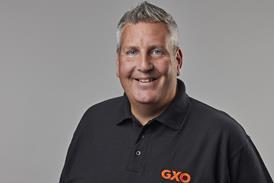
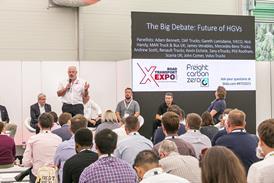
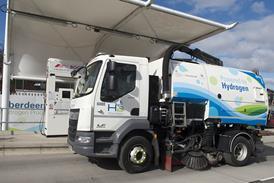


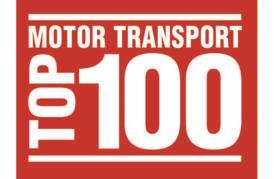
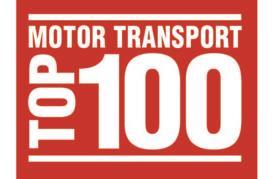
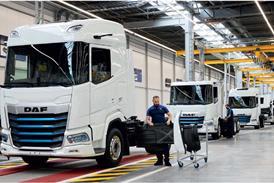
![Mercedes-Benz_eActros_600_(1)[1]](jpg/17820_mercedesbenz_eactros_600_11_978080.jpg)

